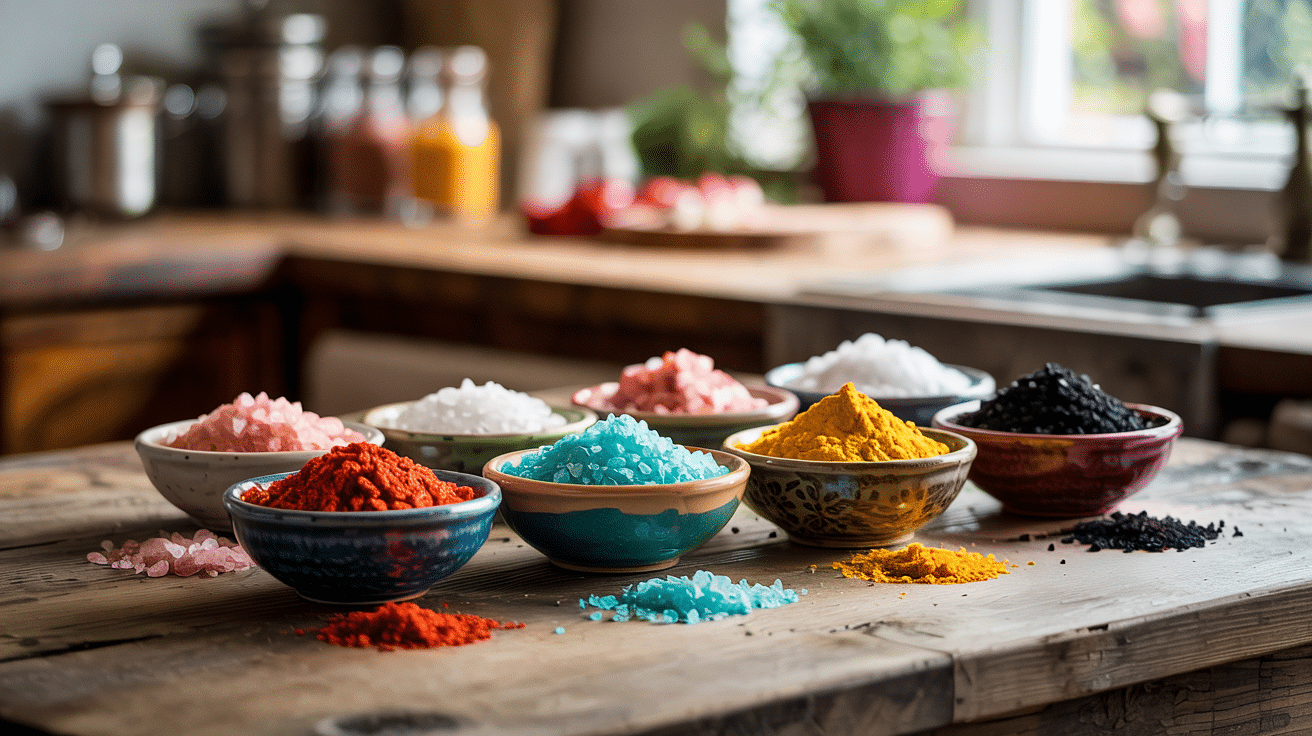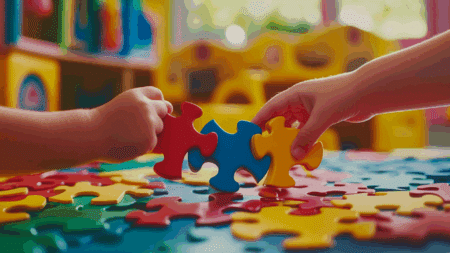Salt can change colors!
Kids often get bored with plain white salt for their craft projects. They want bright colors that pop and shine. But buying colored salt from stores can cost a lot, and the colors might not be what you want.
You can make colored salt at home with things you already have. It’s quick, simple, and fun for kids of all ages. Plus, they’ll get to mix their special colors.
This post will show you easy ways to color salt at home. You’ll learn what materials work best and cool ways to use your colorful creations.
Get ready to add some rainbow magic to your next craft day!
How to Color Salt: Step-by-Step Guide to DIY Colored Salt
Making colored salt is a simple project that brings fun to kids’ crafts. With just a few household items, you can create bright, colorful salt for art projects, sensory play, or decorations.
Here are four easy methods anyone can try at home.
Liquid Food Dye Method

Liquid food coloring gives you bright, strong colors that kids love. This method works fast and uses items most people already have in their kitchen.
Step 1: Gather your supplies. You’ll need salt, liquid food coloring, a mixing bowl, and a baking sheet lined with paper.
Step 2: Pour salt into the bowl. Start with about one cup of regular table salt or sea salt.
Step 3: Add 3-5 drops of food coloring. Less gives pastel colors, more makes them brighter.
Step 4: Mix well with a spoon. Keep mixing until the color spreads evenly through all the salt.
Step 5: Spread on paper to dry. Let it sit for about an hour, then break up any clumps with your fingers.
Gel-Based Food Coloring Method

Gel colors make rich, bold shades that stand out more than liquid dyes. They work well for making darker or more intense colors.
Step 1: Set up your work area. Put down some old newspaper to protect your table from stains.
Step 2: Pour salt into a zip-top bag. Using a bag helps contain the mess and makes mixing easier.
Step 3: Add a small dab of gel color. Start with just a tiny amount on a toothpick – gel colors are strong!
Step 4: Seal the bag and shake. Make sure to remove air from the bag first, then shake until all salt is covered.
Step 5: Pour onto a tray to dry. Spread it in a thin layer and let it air dry for 2-3 hours before using.
Coloring with the Chalk Method

This method uses chalk dust to create soft, pastel colors. It’s cleaner than food coloring and dries faster, too.
Step 1: Choose your chalk colors. Regular sidewalk chalk works great for this method.
Step 2: Grind chalk into powder. Use a cheese grater or rub chalk on sandpaper to make fine dust.
Step 3: Mix chalk powder with salt. Combine in a bowl with a 1:10 ratio of chalk to salt.
Step 4: Blend thoroughly. Use a whisk or fork to mix until the color looks even throughout.
Step 5: Store in an airtight container. No drying needed – the chalk-colored salt is ready to use right away!
Adding Watercolor or Gouache For Unique Effects

Watercolors and gouache paints can create salt with special effects and subtle color shifts not possible with food dyes.
Step 1: Prepare a thin paint mixture. Mix watercolor or gouache with a bit of water in a small cup.
Step 2: Pour salt into a shallow dish. Spread it out so it forms a thin, even layer.
Step 3: Drip paint onto the salt. Use a pipette or brush to add small amounts of paint.
Step 4: Let colors blend naturally. Don’t mix – let the paint spread through the salt on its own.
Step 5: Dry completely. This method needs more drying time, usually overnight, before the salt is ready to use.
Tips to Dry and Store Colored Salt for Long-Term Use

Getting your colored salt completely dry and storing it well keeps the colors bright and the salt ready to use. With proper care, your DIY colored salt can last for months of creative play.
Techniques for Drying Colored Salt
- Spread salt in a thin layer on a baking sheet or tray lined with parchment paper or paper towels.
- Break up clumps regularly with a fork or your fingers to help it dry evenly.
- Use low heat to speed up drying by placing the salt in an oven at the lowest temperature for 10-15 minutes.
- Let it air dry completely for at least 2-3 hours for food coloring methods and up to 24 hours for paint-based colors.
- Test for dryness by making sure the salt is loose and doesn’t stick together when touched.
Proper Storage Methods for Colored Salt
- Use airtight containers like mason jars, plastic food storage containers, or zip-top bags.
- Label each color with the name and date to track how long you’ve had it.
- Store in a cool, dry place away from direct sunlight to prevent color fading.
- Add a desiccant packet to each container to absorb any moisture.
- Check before each use to make sure the salt hasn’t clumped or changed color.
Fun Ways to Use Colored Salt in Crafts and Sensory Play
Colored salt opens up a world of creative possibilities for kids and adults alike. Once you’ve made your rainbow of salt colors, try these fun ways to put them to use in your home or classroom.
| Creative Use | Explanation | Ingredients Needed | Kid-Friendly Level |
|---|---|---|---|
| Salt Mandala Art | Kids can create vibrant mandalas by pouring colored salt into patterns. | Colored salt, paper plate, glue (optional), funnel/spoon | Very kid-friendly |
| Sensory Bottles | Shake and swirl the layered colored salt in a bottle for a calming effect. | Colored salt, clear plastic bottle, funnel | Excellent |
| Salt and Glue Painting | Glue designs are sprinkled with colored salt for textured artwork. | White glue, paper, colored salt, small paintbrush | Very kid-friendly |
| Mini Zen Garden | Use colored salt as “sand” for a peaceful play space with mini rakes. | Tray, colored salt, mini rake, or stick | Supervised play |
| Rainbow Salt Jars | Layer different colors of salt in a jar for a beautiful rainbow effect. | Clear jar, multiple shades of colored salt, spoon | Excellent |
Avoid These Mistakes When Coloring Salt

When making colored salt, a few common mistakes can turn your fun craft project into a frustrating mess. Here’s how to avoid these pitfalls and ensure your salt coloring goes smoothly every time.
- Adding too much liquid coloring causes salt to clump and take forever to dry.
- Rushing the drying process results in damp salt that sticks together and may develop mold.
- Use coarse salt varieties that don’t hold color as well as fine table salt or sea salt.
- Mixing colors in plastic containers that can become permanently stained by the dyes.
- Store colored salt in paper bags or cardboard, which can absorb moisture and ruin your creation.
Wrapping Up Your Colored Salt Escapade
Now you know how to make beautiful colored salt using simple items from your home. Whether you choose food coloring, gel colors, chalk, or watercolors, each method gives you unique results for your craft projects.
Remember to dry your salt completely and store it in airtight containers to keep it fresh for months. Avoid common mistakes like using too much dye or rushing the drying process.
Try making a rainbow salt jar, creating a salt painting, or building a colorful sensory bin for the kids. The possibilities are endless with this easy craft material.
Have you tried coloring salt before? Share your creations in the comments below! And if you enjoyed this guide, check out our other DIY craft ideas for kids.




